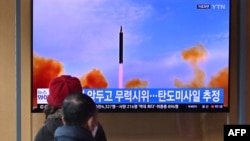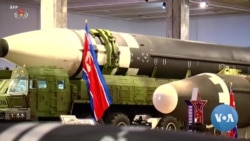North Korea's last two missile launches were tests of a new intercontinental ballistic missile (ICBM) system, U.S. officials said Thursday, as they announced fresh sanctions on Pyongyang and warned of a "serious escalation" in tensions.
The launches on Feb. 26 and March 4 did not demonstrate ICBM range but were likely meant to evaluate the new system before conducting a future test at full range, potentially disguised as a space launch, according to a statement from Pentagon spokesperson John Kirby.
North Korea had not given many details about the tests other than to say they were in preparation for the launch of a military spy satellite.
On Friday, state media reported North Korean leader Kim Jong Un visited the country's Sohae Satellite Launching Ground. Pictures showed Kim, wearing a black leather jacket and sunglasses, speaking with top defense officials as they stood in front of a launch tower.
Kim announced plans to "build a number of new elements in the launching ground so as to launch the military reconnaissance satellite and other multipurpose satellites by diverse carrier rockets in the future," said a report by the Korean Central News Agency.
A day earlier, Kim said the spy satellite would provide "real-time information" on the movements of "the aggression troops of the U.S. imperialism and its vassal forces" in the region. None of the reports said when such a launch would occur.
North Korea had not conducted an ICBM launch since 2017, during the height of tensions between Kim and former U.S. President Donald Trump. A year earlier, North Korea had attempted to launch a satellite. The United States and its allies view North Korean satellite launches as thinly disguised tests of long-range missile technology banned by United Nations Security Council resolutions.
A satellite launch would dramatically raise tensions on the Korean Peninsula. On Thursday, conservative former prosecutor Yoon Suk-yeol was declared the winner of South Korea's presidential election. Yoon has promised a much more forceful approach to North Korea.
In his first press conference Thursday as president-elect, Yoon promised to "sternly" address North Korean provocations but insisted he is open to dialogue with Pyongyang.
'Monster missile'
That dialogue will not happen anytime soon, it appears. So far this year, North Korea has launched 13 missiles during nine rounds of launches. The tests are seen as part of an effort to systematically work through a wish list of strategic weapons laid out by Kim last year.
On Kim's wish list is an ICBM large enough to carry multiple warheads — a capacity that would make it much harder for U.S. missile defenses to intercept. North Korea unveiled such an ICBM, the Hwasong-17, during a parade in October 2020. Experts dubbed it the "monster missile."
According to U.S. officials, North Korea's last two launches involved the Hwasong-17, although only in some limited capacity. The tests likely only involved the first stage of the two-stage rocket, said Joshua Pollack, a researcher at the James Martin Center for Nonproliferation Studies.
The South Korean and Japanese militaries had reported the missiles only flew for about 300 kilometers, reaching a maximum altitude of 550-600 kilometers. The Hwasong-17 is estimated to have a maximum range of about 13,000 kilometers.
At the time, North Korea said one of the launches was meant to test "attitude control devices" on the rocket, suggesting it was experimenting with a system that could control a camera on a spy satellite. But "the attitude control system used to point the camera is likely the same system one would use to aim multiple warheads," tweeted Jeffrey Lewis, an expert in nuclear nonproliferation with the Middlebury Institute of International Studies at Monterey.
"Drop a warhead, turn around, drop another, and so on," Lewis said.
Missile defense complications
Such a system, known as a multiple independently targetable reentry vehicle, or MIRV, would be much harder for U.S. missile defenses to intercept, according to Ankit Panda, a nuclear policy specialist at the Carnegie Endowment for International Peace.
“If the North Koreans were to launch 10 ICBMs with a single warhead each, the U.S. technically, although our interceptors don’t work very well, has the number of interceptors necessary to deal with that scenario,” Panda said. “If the North Koreans placed two, three, four, or more warheads on a single missile, the arithmetic for U.S. ballistic missile defense begins to look incredibly unfavorable.”
Another reason North Korea is developing MIRVs is their shortage of mobile launch systems, known as transporter erector launchers, or TELs.
“The North Koreans have had a difficult time building very large trucks that are reliable and capable of carrying and launching these missiles,” Panda said.
Putting multiple warheads on a single missile reduces the need for mobile launchers.
“Not only are MIRVs more cost effective, they're actually a necessity If the North Koreans want to enhance their ability to deal damage to the United States with their nuclear weapons, which is what they need for nuclear deterrence to actually work,” Panda added.
In its previous two tests, North Korea apparently used a mobile launch system placed at an airport near Pyongyang. But Kim’s visit to the Sohae satellite launch facility suggests the upcoming satellite launch will use the facilities there.
'Serious escalation'
Speaking to reporters on condition of anonymity, a U.S. official described the tests as a "serious escalation" in North Korea's missile program. The U.S. Treasury on Friday will announce new sanctions meant to prevent North Korea from "accessing foreign items and technology that enable it to advance its weapons programs," the official added.
Early Friday, South Korea's military also released an assessment saying it believed North Korea had tested an ICBM.
"Our government strongly condemns North Korea's launch of such ballistic missiles, which are in violation of many United Nations Security Council resolutions, and urges North Korea to immediately stop acts that create security anxiety on the Korean Peninsula and in the region and heighten tensions," it said.











